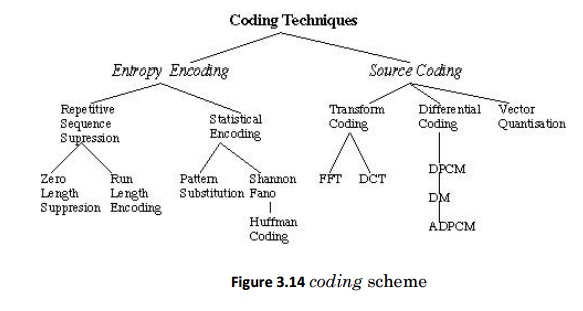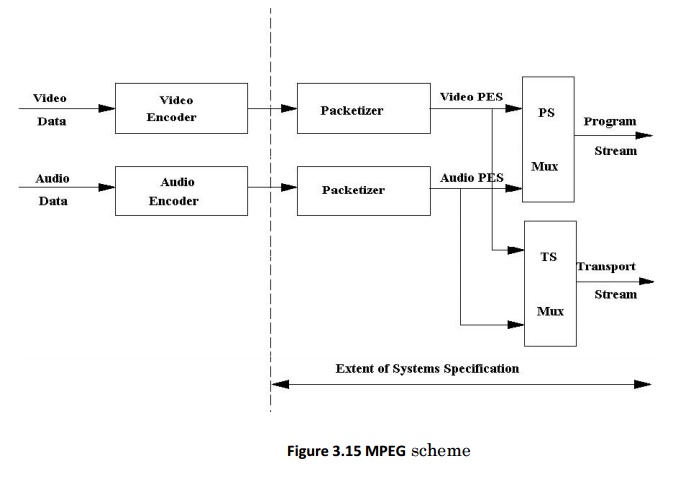Chapter: Satellite Communication : Satellite Access
Compression - Encryption
Compression -
Encryption:
At
the broadcast center, the high-quality digital stream of video goes through an
MPEG encoder, which converts the programming to MPEG-4 video of the correct
size and format for the satellite receiver in your house.
Encoding
works in conjunction with compression to analyze each video frame and eliminate
redundant or irrelevant data and extrapolate information from other frames.
This process reduces the overall size of the file. Each frame can be encoded in
one of three ways:
As an intraframe, which contains the complete image data for that frame.
This
method provides the least compression.
As a predicted frame, which contains just enough information to tell the
satellite receiver how to display the frame based on the most recently
displayed intraframe or predicted frame.
As a bidirectional frame, which displays information from the surrounding
intraframe or predicted frames. Using data from the closest surrounding frames,
the receiver interpolates the position and color of each pixel.
This
process occasionally produces artifacts -- glitches in the video image. One
artifact is macroblocking, in which the fluid picture temporarily dissolves
into blocks. Macroblocking is often mistakenly called pixilating, a technically
incorrect term which has been accepted as slang for this annoying artifact.
There
really are pixels on your TV screen, but they're too small for your human eye
to perceive them individually -- they're tiny squares of video data that make
up the image you see.
The
rate of compression depends on the nature of the programming. If the encoder is
converting a newscast, it can use a lot more predicted frames because most of
the scene stays the same from one frame to the next.
In
more fast-paced programming, things change very quickly from one frame to the
next, so the encoder has to create more intraframes. As a result, a newscast
generally compresses to a smaller size than something like a car race.
1. Encryption
and Transmission:
After
the video is compressed, the provider encrypts it to keep people from accessing
it for free. Encryption scrambles the digital data in such a way that it can
only be decrypted (converted back into usable data) if the receiver has the
correct decryption algorithm and security keys.
Once
the signal is compressed and encrypted, the broadcast center beams it directly
to one of its satellites. The satellite picks up the signal with an onboard
dish, amplifies the signal and uses another dish to beam the signal back to
Earth, where viewers can pick it up.
In
the next section, we'll see what happens when the signal reaches a viewer's
house.
2. Video and
Audio Compression:
Video
and Audio files are very large beasts. Unless we develop and maintain very high
bandwidth networks (Gigabytes per second or more) we have to compress to data.
Relying
on higher bandwidths is not a good option -- M25 Syndrome: Traffic needs ever
increases and will adapt to swamp current limit whatever this is.
As
we will compression becomes part of the representation or coding scheme which
have become popular audio, image and video formats.
We
will first study basic compression algorithms and then go on to study some
actual coding formats.

What is Compression?
Compression
basically employs redundancy in the data:
Temporal -- in 1D data, 1D signals, Audio etc.
Spatial -- correlation between neighbouring pixels or data items
Spectral -- correlation between colour or luminescence components. This uses
the frequency domain to exploit relationships between frequency of change in
data.
psycho-visual -- exploit perceptual properties of the human visual system.
Compression
can be categorised in two broad ways:
Lossless Compression :
--
where data is compressed and can be reconstituted (uncompressed) without loss
of detail or information. These are referred to as bit-preserving or reversible
compression systems also.
Lossy Compression :
--
where the aim is to obtain the best possible fidelity for a given bit-rate or
minimizing the bit-rate to achieve a given fidelity measure. Video and audio
compression techniques are most suited to this form of compression.
If
an image is compressed it clearly needs to uncompressed (decoded) before it can
viewed/listened to. Some processing of data may be possible in encoded form
however. Lossless compression frequently involves some form of entropy encoding
and are based in information theoretic techniques.
Lossy
compression use source encoding techniques that may involve transform encoding,
differential encoding or vector quantization.
3. MPEG
Standards :
All
MPEG standards exist to promote system interoperability among your computer, television
and handheld video and audio devices. They are:
MPEG-1: the original standard for encoding and decoding streaming video and
audio files.
MPEG-2: the standard for digital television, this compresses files for
transmission of high-quality video.
MPEG-4: the standard for compressing high-definition video into smaller- scale
files that stream to computers, cell phones and PDAs (personal digital
assistants).
MPEG-21: also referred to as the Multimedia Framework. The standard that
interprets what digital content to provide to which individual user so that
media plays flawlessly under any language, machine or user conditions.

Related Topics